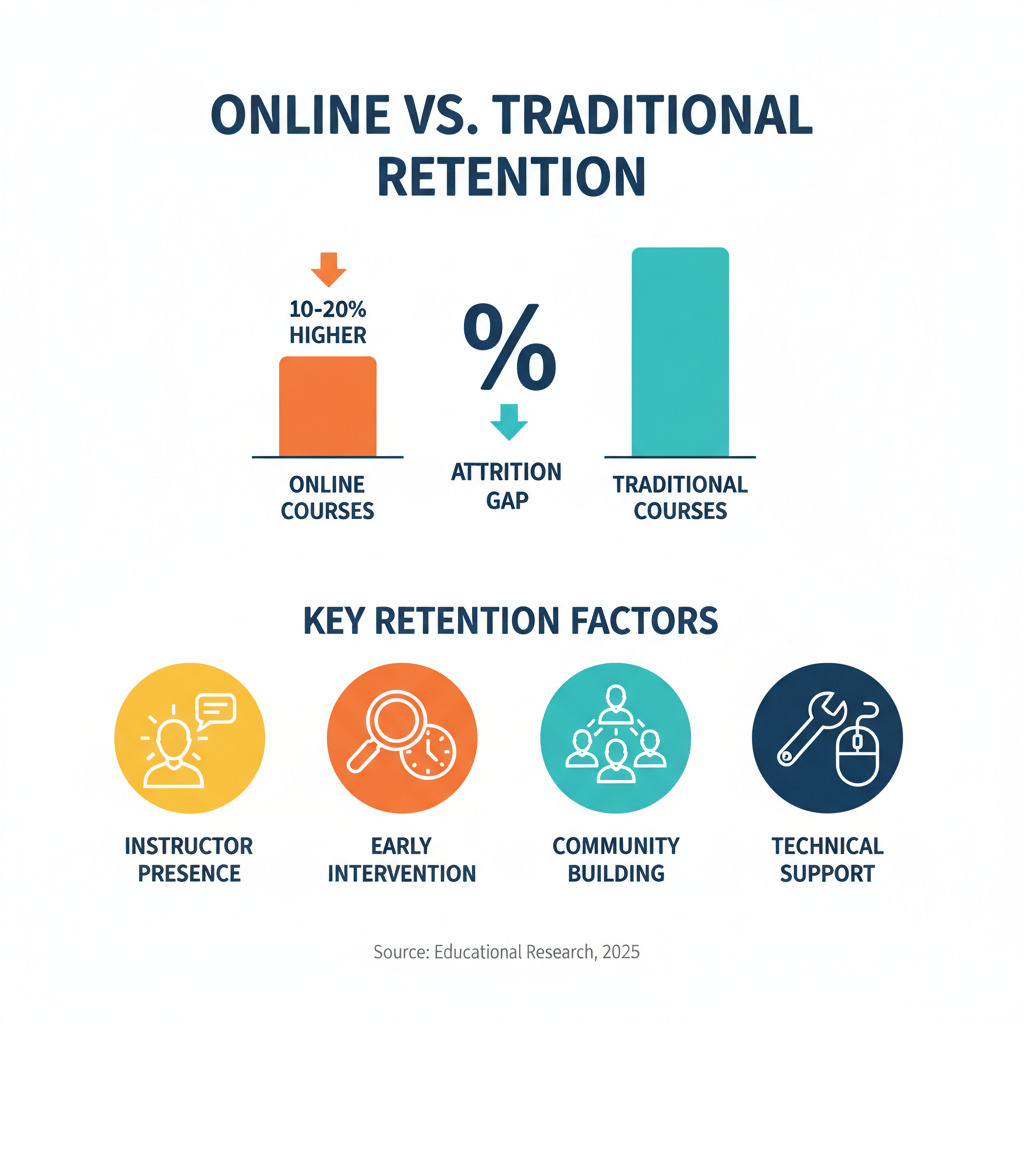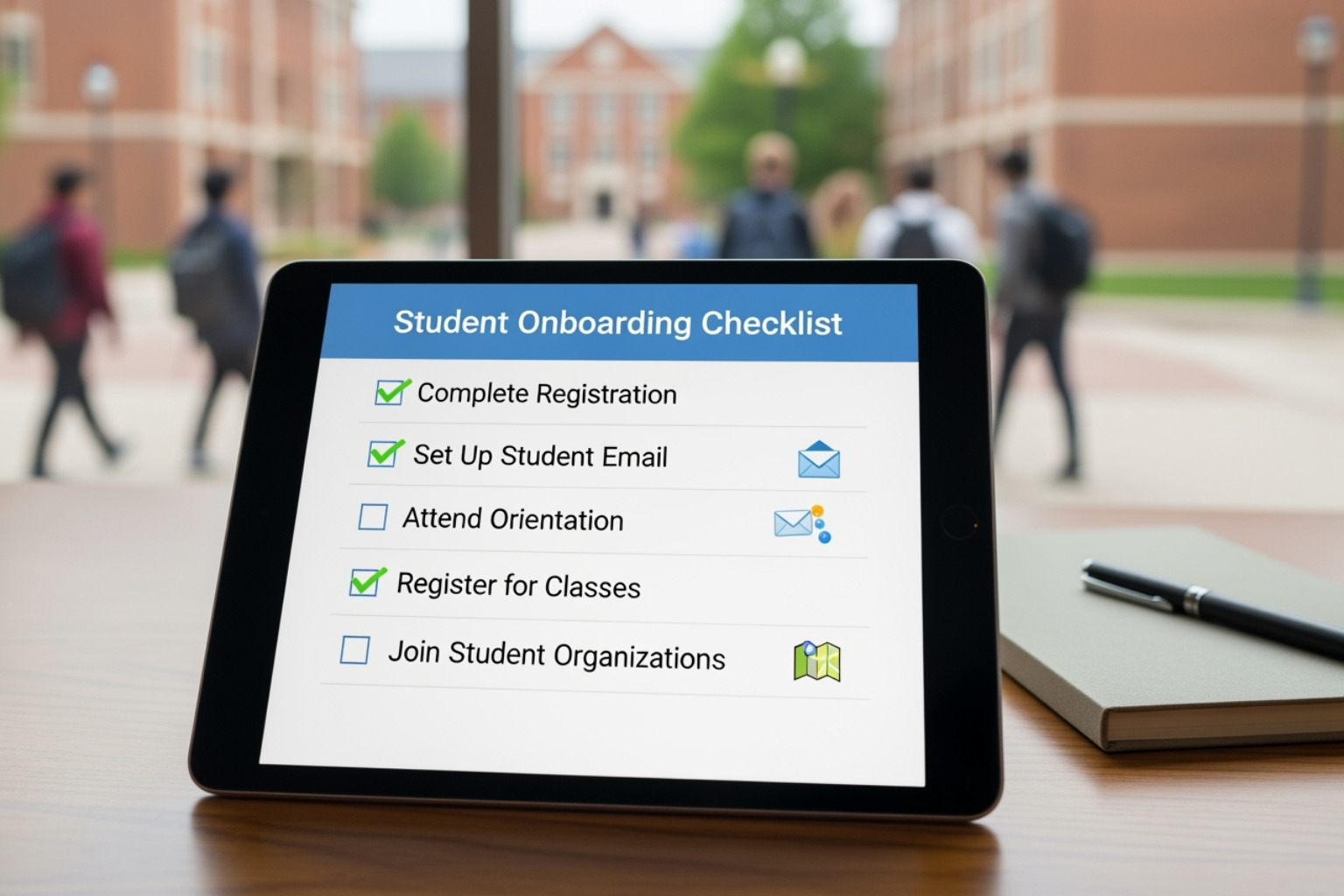Why Online Student Retention Has Become a Critical Challenge

Online student retention strategies are more crucial than ever as educational institutions face higher dropout rates in digital learning environments. Online courses historically show a 10-20% higher attrition rate than traditional classes, with some studies indicating that 40-80% of students drop out of online programs.
The most effective online student retention strategies include:
- Proactive instructor communication – Regular outreach and timely feedback
- Comprehensive onboarding – Technology verification and clear expectations
- Early intervention systems – Identifying at-risk students quickly
- Building community – Fostering peer connections and belonging
- Flexible support services – 24/7 technical help and academic assistance
- Course design optimization – Chunking content and providing quick wins
The shift to online learning revealed that many retention models for traditional classrooms don’t translate to digital environments. Students often struggle with information overload, technical difficulties, and isolation.
The fundamental challenge isn’t the students themselves—it’s adapting teaching methods and support systems to meet learners in the digital space. Successful retention requires a blend of technological solutions and genuine human connection, an approach we’ve honed by helping educational institutions improve their digital presence and student engagement.

Foundational Strategies: Setting Students Up for Success

Effective online student retention strategies begin before the first lesson. Success in online learning requires careful preparation, much like planning a road trip. The numbers are sobering: online courses often have retention rates 10-20% lower than face-to-face classes. However, most dropouts stem from preventable challenges, not a lack of ability.
Preparing Learners for the Online Environment
The foundation of retention is a comprehensive onboarding experience that sets realistic expectations. This goes beyond a simple welcome email.
- Digital literacy assessment: A simple self-assessment can identify students who need extra tech support before they fall behind. Many overestimate their skills beyond social media.
- Technology verification: Ensure students have a computer (not just a phone) and a stable internet connection. This prevents major roadblocks later.
- Mandatory orientation: A required orientation covering course navigation, communication expectations, and time management builds confidence in the online environment.
Research by Muljana & Tian confirms that student academic factors, especially study skills, are crucial for retention. Providing upfront training makes a significant difference.
For more insights, check out our guide on researching your audience or explore a dozen strategies for improving online student retention.
Communicating Clear Objectives and Quick Wins
Confusion kills motivation. Clear learning outcomes and early achievements are essential online student retention strategies.
- Clear learning objectives: Go beyond academic jargon. Instead of “understand marketing principles,” try “you’ll create your first social media campaign within two weeks.” This approach is used well in programs like this security guard training course, where objectives are practical and exciting.
- Quick wins: Small, early accomplishments build momentum and show students their investment is paying off. This could be completing a first project or mastering a key concept.
Think of it as a results roadmap, breaking the journey into manageable milestones. This scaffolding makes ambitious programs feel achievable and keeps students motivated through challenges. When students see their progress and feel confident, they are far more likely to persist.
The Human Element: Building Community and Instructor Presence
Technology may power online learning, but human connections drive student success. Isolation is a primary reason students drop out. For vocational and trade schools, where students value hands-on connections, recreating a sense of belonging online is critical.
Research shows that faculty presence and interaction are key to online student retention strategies. When students feel seen, supported, and connected to peers and instructors, they stick around.
Fostering a Strong Learning Community
Vocational students thrive on collaboration. We must deliberately create opportunities for connection in online courses.
- Engaging discussion forums: Go beyond Q&A. Pose real-world scenarios that spark debate, like asking welding students to discuss safety protocol violations.
- Collaborative projects: Group assignments and peer reviews help students learn from each other while building relationships.
- Small cohorts: For large classes, creating smaller study groups of 15-20 peers makes the experience more intimate.
- Accountability partnerships: Pairing students to check in on goals creates a powerful support system for adult learners juggling multiple responsibilities.
As Gillian Perkins demonstrates in her Creating a community for entrepreneurs programs, dedicated spaces for interaction are powerful. The goal is to make community-building feel natural, not forced. For more ideas, our More on social media for community services can help.
The Impact of Proactive Instructor Communication

Proactive instructor communication is arguably the most impactful of all online student retention strategies. Instructors are the human face of your institution.
- Regular announcements: Do more than share deadlines. Celebrate achievements, preview upcoming content, and remind students of their goals.
- Timely, constructive feedback: Quick, specific, and supportive responses show students their work matters and guide them on how to improve.
- Personalized outreach: A simple “How are things going?” email to a student who hasn’t logged in can be a lifeline. It shows they aren’t anonymous.
- Acknowledge struggles and successes: Reaching out to struggling students and congratulating high performers shows instructors are paying attention to individual progress.
A retention study found that “A caring attitude of college personnel is viewed as the most potent retention force on a campus.” This attitude must shine through every interaction. Proactive communication benefits everyone, creating a more connected and rewarding experience for both students and instructors. For actionable strategies, see Engaging Students through Communication and Contact. A study on faculty competence and student engagement also reinforces the importance of these relationships.
Smart Course Design: Key Online Student Retention Strategies
An online course should be a carefully crafted experience, not just a digital information dump. The best online student retention strategies involve intentional design that works with the digital medium. Online students face unique challenges, including juggling responsibilities while staring at screens. Without thoughtful course design, even motivated students can become overwhelmed.
Smart design uses active learning, structures content in digestible ways, and creates multiple touchpoints for feedback, making students feel supported and able to see their progress.
Designing for Engagement: Actionable online student retention strategies
Information overload is the enemy of online student success. When students see weeks of dense content, they often log out and don’t return.
- Chunking content: Break long lectures into shorter, bite-sized modules. This respects busy schedules and provides achievable stopping points.
- Interactive elements: Quizzes, polls, and hands-on activities transform passive learners into active participants, improving material retention.
- Video lessons: Seeing an instructor on camera creates a sense of connection that text cannot match.
- Downloadable resources: Templates, checklists, and guides provide tangible value and support different learning preferences.
- Gamification: Progress bars, badges, or point systems can provide a motivational boost by making progress visible and celebrating small wins.
The goal is to offer variety in content delivery and assessment. For guidance on scaling these approaches, see Strategies for managing large online classes. Additionally, A guide to active learning techniques offers more insights.
Using Feedback to Improve the Student Experience
Feedback is a two-way street and crucial for online student retention strategies. Students need feedback on their progress, and instructors need feedback to improve the course.
- Constructive and timely feedback: Specific, supportive, and prompt feedback guides students toward improvement and shows they are seen.
- Formative assessments: Low-stakes checkpoints like quick polls or brief quizzes act as early warning systems for struggling students.
- Mid-semester surveys: Anonymous surveys provide invaluable insights while there’s still time to make adjustments. Acting on this feedback shows students their voices matter.
- Student-led improvements: When instructors implement changes based on feedback, it builds trust and creates a collaborative learning environment.
This continuous improvement approach ensures strategies evolve based on real student needs. For more on this, Effective feedback strategies for online courses offers comprehensive insights.
The Support Network: Proactive Intervention and Resources
Even with great course design, some students will face challenges. A robust support network, built on proactive intervention, is a non-negotiable part of successful online student retention strategies.

Nontraditional online students often juggle responsibilities that can lead to academic trouble, making early intervention critical for vocational and career colleges. Waiting for students to ask for help is often too late. Proactive support is essential.
Identifying At-Risk Students: Proactive online student retention strategies
Effective intervention means knowing when students need help. Modern technology provides powerful tools to spot struggling students early.
- Learning analytics: Your Learning Management System (LMS) can reveal red flags, like a student who suddenly stops logging in.
- Participation monitoring: A sudden silence in discussion forums or a drop in live session attendance often signals a student is overwhelmed.
- Grade tracking: Look for more than just failing scores. Inconsistency, like a top student suddenly submitting C-level work or missing deadlines, is a key indicator.
- Behavioral triggers: Set up automatic alerts for inactivity or when students post phrases like “I’m lost.” This allows for immediate outreach.
Once identified, a simple email or call asking if everything is okay can be the lifeline that prevents a student from dropping out. Our Web Development Services can ensure your platform is usable and equipped with the analytics tools to spot these warning signs.
Providing Robust Technical and Academic Support
Identifying at-risk students is the first step. The next is to wrap them in a comprehensive support network.
- 24/7 technical support: This is essential for students learning on non-traditional schedules. A minor tech issue can become a course-ending disaster without it.
- Dedicated support staff: Student success coaches and academic advisors who specialize in online learning can address the root causes of a student’s struggles.
- Online tutoring services: Synchronous or asynchronous tutoring provides crucial academic scaffolding.
- Mentoring programs: Pairing new students with successful alumni or faculty mentors provides both practical guidance and emotional support against isolation.
- Financial aid resources: Proactively share information about scholarships and grants, as financial worries are a top reason students drop out.
Most importantly, normalize asking for help. Create a culture where seeking assistance is seen as a smart move. This holistic approach, as confirmed by a systematic review of retention strategies, significantly improves retention rates.
Frequently Asked Questions about Online Student Retention
What are the primary reasons students drop out of online courses?
While poor grades are a factor, the biggest reasons are often more subtle. They include:
- Isolation: Students miss the natural interactions of a physical classroom and feel disconnected.
- Poor course design: Content that isn’t adapted for digital learning can be overwhelming and unengaging.
- Underestimating the time commitment: Many students assume online learning is “easier” and are unprepared for the self-discipline required.
- Technical difficulties: Persistent platform issues or poor connectivity create frustration that can become a final straw.
- Inadequate support: Without quick access to academic or technical help, small problems can become impossible obstacles.
What is the single most impactful retention strategy?
If you focus on one thing, make it proactive instructor presence and communication. Research consistently shows this is the most critical factor in online student retention strategies. When an instructor is actively engaged—responding quickly, offering personalized feedback, and checking in on struggling students—learners feel seen and supported. This human touch combats the isolation that kills motivation and makes students far more likely to persist through challenges.
How can institutions best prepare students for online learning?
A comprehensive onboarding process is key. This goes beyond a welcome email and should include:
- A mandatory orientation: Set realistic expectations about time commitment and the self-discipline needed for online success.
- Technology verification: Before classes start, confirm students have a reliable computer and internet. Provide tutorials for the learning platform.
- Digital literacy training: Offer support for basic digital skills like file management and online communication etiquette.
- Clear communication: Ensure students understand course objectives, assessment methods, and available support services from the start.
- Self-assessment tools: Help students evaluate their readiness for online learning so they and the institution can identify potential support needs early.
Investing in thorough preparation sets every student up for success.
Conclusion
Effective online student retention strategies aren’t about a single solution. They require weaving together technology, teaching methods, and genuine human care into a comprehensive support system.
Every department plays a role. Admissions sets expectations, IT provides access, instructors offer a human connection, and student services provides a safety net. For vocational schools, trade schools, and career colleges, the stakes are particularly high. Your students are investing in new career paths, and a dropout represents a deferred dream and a financial strain.
This is why retention matters so deeply. By focusing on proactive communication, community building, engaging course design, and robust support systems, you honor the trust your students have placed in you.
Small changes can yield big improvements: a “we missed you” email, a redesigned video lecture, or an answered tech support call. At Brain Jar, we’ve seen how a solid digital foundation transforms the student experience. When your website and learning platform are intuitive and fast, you’re setting students up for success from day one.
Understanding how students interact with your online platforms can reveal critical insights. Learn how Usability Studies for Educational Institutions can improve your student experience and retention—because sometimes, improving retention is as simple as making your course navigation more intuitive.
Your students are counting on you. With thoughtful online student retention strategies that put human connection at the center of digital learning, you can ensure their trust pays off.
